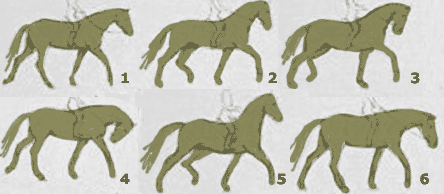Sv: Varför publicerar Ridsport en 5 år gammal intervju?
Det här är också mycket märkligt formulerat:
THE EFFECT OF DIFFERENT HEAD AND NECK POSITIONS ON THE
THORACOLUMBAR KINEMATICS IN THE UNRIDDEN HORSE
P.R. Van Weeren,
C. Johnston
L. Roepstorff,
M. A. Weishaupt
1 Department of Equine Sciences, Utrecht University, The Netherlands.
<r.vanweeren@vet.uu.nl>
Reasons for performing the study: In many equestrian activities a specific position of head
and/or neck is required that is dissimilar to the natural position. Much controversy exists on the
impact of these positions, but no quantitative data are available.
Objectives: To quantify the effect of 5 different head and neck positions on thoracolumbar
kinematics of the horse.
Methods: Kinematics of 7 high level dressage horses were measured walking and trotting on an
instrumented treadmill with the head and neck in the following positions:
HNP2=neck raised, bridge of the nose in front of the vertical;
HNP3=as HNP2 with bridge of the nose behind the vertical;
HNP4=head and neck lowered, nose behind the vertical;
HNP5=head and neck in extreme high position;
HNP6=head and neck forward downward.
HNP1 was a speed-matched control (head and neck unrestrained) for all measurements.
Results:
The head and neck positions only affected vertebral angular motion patterns (AMP) in
the sagittal plane (flexion-extension). There was
no influence on lateral bending or axial rotation.
The positions in which the neck was extended (
HNP2, 3, 5) increased extension in the anterior
thoracic region, but increased flexion in the posterior thoracic and lumbar region. For
HNP4 the
pattern was opposite. Range of motion (ROM) of vertebrae was reduced at walk in the lumbar
region in
HNP2 and
5, and at trot also in
HNP3. Restriction was more evident at trot than at walk
and most evident in
HNP5. In this position there was an
increase in ROM of lateral bending in the
thoracic region at walk and of
axial rotation at trot. In
HNP4 there was an overall increase in
flexion-extension ROM, at walk mainly thoracic, at trot also lumbar.
HNP5 was the only position
that negatively affected intravertebral pattern symmetry and reduced hind limb protraction.
Conclusions: There is a significant influence of head/neck position on thoracolumbar kinematics,
principally in the sagittal plane. Positions with an elevated neck tend to induce extension in the
thoracic region and flexion in the lumbar region. Lower neck positions produce the opposite. High
neck positions generally lead to a restriction of ROM of vertebrae, especially in the lumbar area.
Low neck positions will increase ROM. A very high position of the neck seems to greatly disturb
normal kinematics.
Potential relevance: This study provides quantitative data on the effect of head/neck positions
on the thoracolumbar spine.
Det finns inga referenser till var man kan läsa vidare om hur de gjorde. Är hästarna ridna eller bara ihopdragna med inspänningstyglar? Varför sägs inget om HNP6? För att det gav "trevligare" resultat än HNP4? Eller för att det var omöjligt att få ryttarna att rida så eller en inspänd häst att gå så?
Tessan


